Abstract
Studying the changes in tourist comfort is significant for improving the comfort of the tourism experience and for local tourism economies in the context of global warming. An evaluation and prediction model for ice–snow tourism suitability was constructed to objectively evaluate the suitability of ice–snow tourism environments and provided scientific tourism guidance for tourists. In this study, a comparative analysis was conducted on the monthly average temperature of the Jilin Province (China) over the past 40 years. The results show that in the last ten years, Jilin Province became hotter in the summer half-year and colder in the winter half-year. The corresponding climate comfort index (CCI) rose in the summer half-year and dropped in the winter half-year. The analysis showed that it was no longer suitable to evaluate the tourism experience in winter with the CCI alone. By comprehensively considering the CCI, the index of clothing, and the effects of precipitation, an evaluation and prediction model was constructed for an ice–snow tourism suitability index (ISTSI). The ISTSI comprehensively considered the influences of the environmental temperature, humidity, wind, and precipitation, as well as subjective human initiatives. The test results show that the ISTSI can quantify the degree of comfort of ice–snow tourism and objectively reflect the changes therein. The evaluation process was simpler than the previous methods.
1. Introduction
In 2021, the United Nations’ Intergovernmental Panel on Climate Change (IPCC) officially released the Working Group I report of the IPCC Sixth Assessment Report “Climate Change 2021: The Foundation of the Natural Sciences”. In the report, the IPCC noted that global surface temperatures have risen faster from 1970 to the present than in any other 50-year period. The current global average surface temperature is approximately 1 °C higher than the pre-industrial average surface temperature. Many changes in the climate system are directly linked to increasing global warming. In the context of global warming, researching the regional changes in the degree of comfort in tourism [1,2] is of great significance for providing tourists with an improved and comfortable tourism experience and for developing better local tourism industries.
The climate comfort index (CCI) is a biological–meteorological index based on the heat exchange between the human body and the atmospheric environment, and is usually used to evaluate the comfort state of the human body under different weather and climate conditions. Its evaluation is of far-reaching significance to the development of tourism, especially for the development of vacation travel and tourism destinations [3]. At present, the most common models for climate comfort evaluations can be divided into two major categories: empirical models and mechanistic models [4,5]. The mechanistic models are based on the human heat balance equation, and they have become the mainstream direction of “theoretical research” on climate comfort models in the past 50 years [6,7]. However, the calculation of the human thermal balance equation involves the estimation of many variables, such as the clothing surface average temperature, the skin average temperature, and the human body’s sweating rate [8]. This makes the personalized sample-by-sample (area) processing complicated for a large sample evaluation. If these variables are uniformly valued, parameterized, or estimated, the accuracy of the evaluation model is reduced and the model validity is significantly deteriorated. In contrast, the empirical model is based on each human’s subjective feelings or physiological responses for the evaluation. In this context, the construction of a climate comfort model based on scenario experiments and mathematical statistics has become the most widely used climate comfort evaluation model in practical applications, due to its simple calculations and relatively reasonable results [9,10,11]. Since the 1920s, and after over 40 years of development, the proposal of the Terjung combination model evaluation system in the 1960s remarked that empirical model development was becoming increasingly mature [12,13]. Empirical indices such as the temperature and humidity index [14], the wind chill index, the index of clothing (ICL) [15], and the tourism comprehensive CCI [16,17] were successively proposed. These indices have become commonly used measurement indices for climate comfort forecasts for meteorology [18] and climate comfort evaluations for geography [19]. Influenced by Terjung’s combination model, multi-model combinations have also become a mainstream form of regional climate comfort evaluation [20,21,22]. There are research results on climate comfort in Jilin Province (China). Most studies have used historical climate data to analyze the spatial and temporal characteristics of the tourism comfort index in Jilin Province [23]. Based on an analysis of changes in the number of tourists in certain scenic spots in Jilin Province, and in combination with the meteorological factors such as the daily maximum temperature, the daily average wind speed, and the daily precipitation (snow), a tourism meteorological index standard has been formulated [24]. However, there are relatively few research studies on the comfort of winter ice–snow tourism in Jilin Province at present. For example, the Meteorological Bureau of Chinese Jilin Province has issued the only grading method for an ice–snow tourism index in Jilin Province. This method grades the daily maximum temperature, daily average wind speed, and daily precipitation (snow). During the evaluation, it is necessary to evaluate each element according to its own standard, and then to comprehensively determine the degree of suitability for ice–snow tourism. This method lacks a unique quantitative comparison standard [25], and its application is cumbersome.
In the context of climate warming, and taking Jilin Province (China) as a case study, this study considers the changes in temperature and corresponding human comfort in Jilin Province in the last 40 years, and analyzes their spatio-temporal distribution characteristics. On this basis, an empirical model is used to research the suitability of ice–snow tourism, and the quantitative evaluation and prediction model for an ice–snow tourism suitability index is proposed. This model comprehensively considers the influences of meteorological factors such as temperature, humidity, wind speed, and precipitation on the suitability of ice–snow tourism, and then generates a quantitative evaluation and prediction for the ice–snow tourism suitability index. This evaluation and prediction model can provide an accurate tourism suitability reference for tourists and help improve their experience (comfort). The ice–snow tourism suitability index can objectively evaluate the suitability of ice–snow tourism environments and provide scientific tourism guidance for tourists.
2. Materials and Methods
2.1. Study Area
Jilin Province is located in the northeast of China and has a temperate continental monsoon climate. As they are affected by the westerly circulation system, the temperature, precipitation, and sunshine in the province have evident seasonal changes and large regional differences. The distribution of temperature and sunshine decreases from west to east, and the annual precipitation increases from west to east. There are four distinct seasons in the province, with rain and hot temperatures during the same period. It is dry and windy in spring, warm and rainy in summer, cool and crisp in autumn, and cold and long in winter. The annual average temperature in the province is 5.2 °C. It is the coldest in January and hottest in July. Monsoon prevails in the province, with the maximum wind speeds in spring and small wind speeds in summer. The main wind direction is southwest. The average annual precipitation in the province is 612.2 mm. Affected by the monsoon climate, the precipitation in summer is the highest, accounting for more than 60% of the annual precipitation.
2.2. Data Collection
The data used in this study mainly come from “China Meteorological Data Service Center” (http://data.cma.cn, accessed on 30 December 2021). The statistical analysis data used in this study are the climatic data from 29 surface meteorological observation stations in Jilin Province from 1980 to 2019, and include the monthly average temperature, monthly average maximum temperature, monthly average minimum temperature, monthly average relative humidity, and monthly average wind speed. The test analysis data are the hourly surface observations data from Yongji station and Donggang station on 8 January 2022. The distribution of the 29 stations is shown in Figure 1.
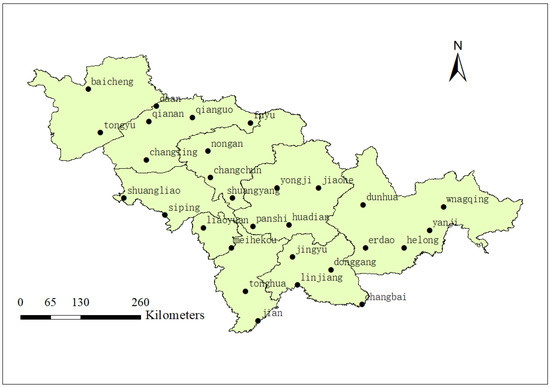
Figure 1.
Distribution map of 29 selected surface meteorological observation stations.
2.3. Methods
First, this study compares the statistics on the monthly average temperature, monthly average maximum temperature, and monthly average minimum temperature in the 30 years from 1980 to 2009 and the 10 years from 2010 to 2019 in Jilin Province. Then, it analyzes the temperature change trend in Jilin Province in the last 40 years. On this basis, the CCI is comparatively analyzed to explore its change trends in regard to the spatio-temporal distribution characteristics. According to the above statistical analysis results, an evaluation and prediction model is established for the suitability of winter ice–snow tourism by using the CCI and ICL and considering precipitation.
The CCI is calculated as follows [26]:
In Equation (1), t is the temperature (°C), v is the wind speed (m/s), and RH is the relative humidity (%).
The ICL is calculated as follows [9]:
In Equation (2), t is the temperature (°C), v is the wind speed (m/s), and H is 75% of the normal metabolic rate of the human body (W/m2) (the metabolic rate of the human body under light activity is taken as 116 W/m2, so H = 87 W/m2). a is the absorption of solar radiation by the human body. It is related to the posture of the human body, albedo of the clothes, and direct radiation, scattering, and reflection of the sun. In most cases, 0.06 is taken corresponding to the absorption of solar radiation of black material (as in this study). R is the solar radiation value (W/m2). α is the solar altitude angle that changes with the latitude. Here, the latitude of a certain place was set by β: in summer, α = 90 − β + 23.26; in winter, α = 90 − β − 23.26; and in spring and autumn, α = 90 − β. The grading standard of the climate comfort index (CCI) and index of clothing (ICL) are shown in Table 1.

Table 1.
Grading standard of the climate comfort index (CCI) and index of clothing (ICL).
3. Results
3.1. Variation of Temperature in Long Time Period
Figure 2 shows the temperature differences in the monthly average temperature between 2010–2019 and 1980–2009 in Jilin Province, China. According to the figure, the temperature differences in January, February, April, and December are negative, and those in March, May, June, July, August, September, October, and November are positive. The most significant differences are in July and December, exceeding +0.8 °C and −0.8 °C, respectively. Figure 3 and Figure 4, respectively, show the temperature differences of the monthly average maximum temperature and monthly average minimum temperature in Jilin Province between 2010–2019 and 1980–2009. Their change trends are roughly the same as the trend of the monthly average temperature. As shown in Figure 3, the extreme values of the average maximum temperature change more significantly, exceeding +1 °C and −1 °C, respectively. The average minimum temperature in October in the last 10 years is also lower than that in the past 30 years. The above results show that the climate of Jilin Province has become hotter in summer and colder in winter in the past 10 years.
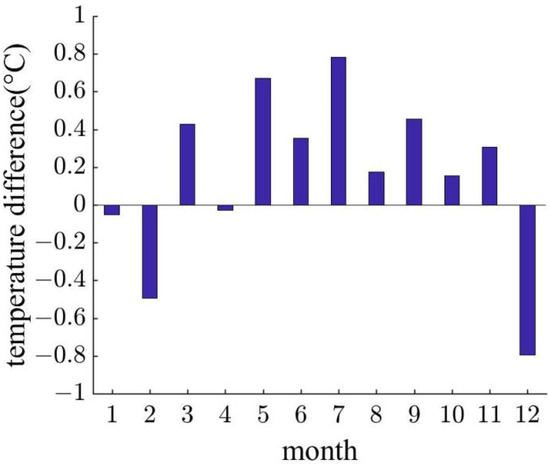
Figure 2.
Temperature difference of monthly average temperature between 2010−2019 and 1980–2009 in Jilin Province, China.
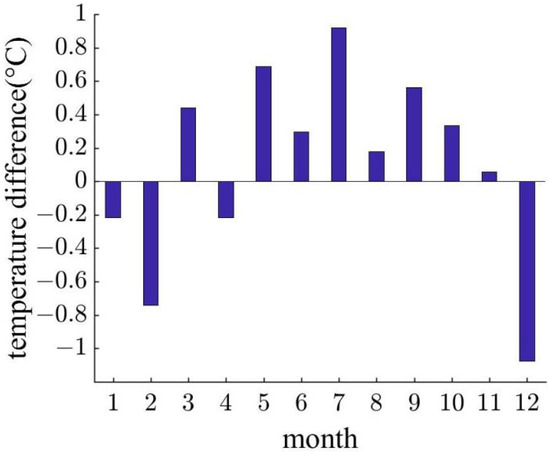
Figure 3.
Temperature difference of monthly average maximum temperature between 2010–2019 and 1980–2009 in Jilin Province, China.
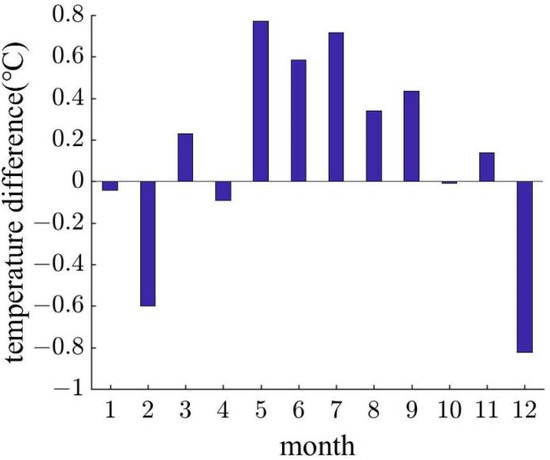
Figure 4.
Temperature difference of monthly average minimum temperature between 2010–2019 and 1980–2009 in Jilin Province, China.
Figure 5 shows the spatial variation of monthly average temperature difference between 2010–2019 and 1980–2009 in Jilin Province. In Jilin Province, spring, summer, autumn and winter are usually from March to May, June to August, September to November, and December to February of the next year, respectively. As shown in Figure 5, the temperature rise in the central area of Jilin Province is smaller than that in the eastern and western areas in spring and autumn. In addition, in the last 10 years, the temperature rise in spring and autumn in the eastern and western areas is more evident than that in the central area; this is especially true for the maximum temperature rise in spring, at 0.9 °C. In summer, the range of temperature rises in the eastern and southeastern mountainous areas of Jilin Province is smaller than that in the central and western areas, and the places with evident temperature rises are in the central and western areas. In winter, the cooling ranges in the eastern and southeastern mountainous areas of Jilin Province are also weaker than those in the central and western areas. The central and western areas of Jilin Province are high-value cooling areas. According to the comprehensive analysis, the ranges of temperature rise and fall in the various areas of Jilin Province are unevenly distributed. The temperature rises and falls in the eastern and southeastern mountainous areas are weaker than those in other areas, whereas the central and western areas show a trend of bipolar strengthening, with a large range of warming and evident cooling.
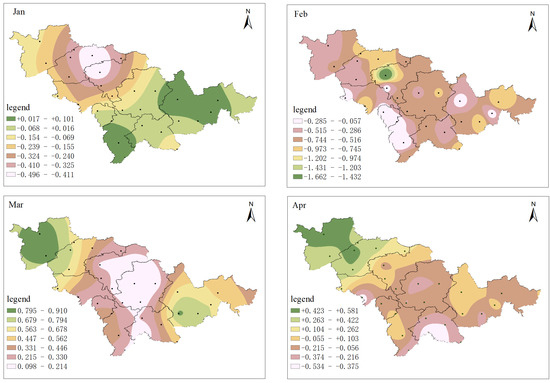
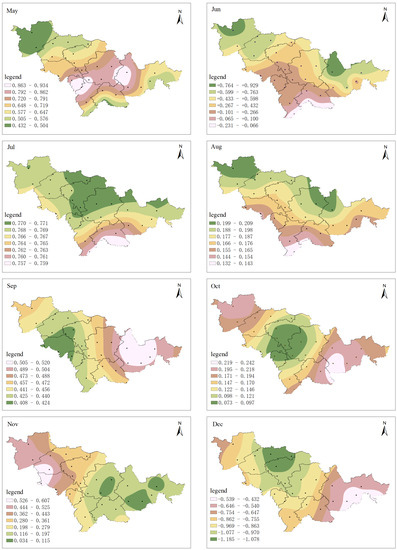
Figure 5.
Spatial variation of monthly average temperature difference between 2010–2019 and 1980–2009 in Jilin Province, China (the unit of legend is °C).
3.2. Statistical Analysis of Climate Comfort Index (CCI)
Figure 6 shows the monthly CCI values for 2010–2019 and 1980–2009 in Jilin Province. The interval value between the two black lines represents the comfort value for most people, and the interval between the two blue lines is the most comfortable interval. As shown in the figure, the CCI in the last 10 years from March to November is higher than that in the previous 30 years, whereas the values in January, February, and December are lower than those in the past 30 years. This shows that with the climate change in Jilin Province in the last 10 years, the CCI has improved from March to November, and people have considered tourism as more comfortable than in the past 30 years. In particular in June, July, and August, the CCI values corresponding to the average maximum and minimum temperatures are both within the scope of most people feeling comfortable, indicating that Jilin Province is the best destination for summer tourism.
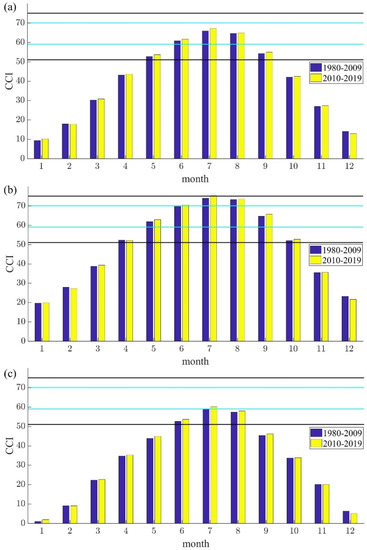
Figure 6.
Monthly climate comfort index (CCI) of 2010–2019 and 1980–2009 in Jilin Province, China ((a): CCI of the average temperature, (b): CCI of average maximum temperature, (c): CCI of average minimum temperature).
Although the CCI of Jilin Province decreases in January, February, and December, this does not mean that the winter tourism environment in Jilin Province has become worse. Due to the fact that Jilin Province is located in the “golden latitude zone” of ice–snow tourism, it is one of the three major powder snow bases in the world [27]. Powder snow is small and light snow with a low moisture content, and the best snow quality for skiing. Jilin Province is the province with the richer ice and snow resources in China and the most advantages in terms of developing the ice and snow industry. Since winter is the busy season of ice–snow tourism in Jilin Province, it is no longer suitable to evaluate the suitability of ice–snow tourism with a single CCI. Therefore, by comprehensively considering the impacts of meteorological factors and human subjective initiatives on the suitability of ice–snow tourism, this study constructs an evaluation and prediction model for an ice–snow tourism suitability index (ISTSI), thereby providing a suitable reference for ice–snow tourism.
4. Evaluation and Prediction Model for Ice–Snow Tourism Suitability Index (ISTSI)
4.1. Construction of Evaluation and Prediction Model for ISTSI
As the main body of tourism, tourists have their own subjective judgment abilities. When in a scenic spot, they can adjust their clothes according to their own feelings and adapt to environmental changes. Nevertheless, when there is heavy snow or sleet (causing road icing), this will seriously affect travel. Strong wind (>8 m/s) will also affect travel activities. Therefore, when constructing the evaluation and prediction model for the ISTSI, this study comprehensively considers the CCI, ICL, precipitation, and strong wind, as follows: ISTSI = [CCI, ICL, S] (S represents precipitation and strong wind). The index grading standard mainly refers to the standard in “the grading method of ice-snow tourism index in Jilin Province” as issued by the Jilin Meteorological Bureau of China (see Table 2 for details). The standard uses the data of meteorological elements such as precipitation, temperature, and wind speed in Jilin Province for 30 years (as combined with a multiple regression analysis) to analyze the changes in meteorological elements and tourist numbers in the north scenic area of Changbai Mountain. Based on the analysis results, a preliminary index grading standard for the comprehensive tourism index is obtained. This index grading standard is then applied to other scenic spots for rationality testing. Ultimately, the grading standard for the ice–snow tourism index in Jilin Province is obtained [25].

Table 2.
Grading standard for ice–snow tourism index in Jilin Province.
Due to the fact that the change in the relative humidity in winter in Jilin Province is very small and its impact on tourists is correspondingly small, the grading method does not consider the impact of the change in relative humidity. When calculating the CCI and ICL indices, the relative humidity is taken as 60%, i.e., the average relative humidity in winter in Jilin Province (see Table 3 for the specific grading results). As the CCI and ICL are negatively correlated (under the same change trend of meteorological conditions, the increases or decreases in the CCI and ICL are opposite), the ISTSI is defined as follows:
CCI and ICL are calculated according to Formulas (1) and (2), respectively. The S, in case of moderate snow and below, is taken as 0, and has no impact on the ISTSI. In cases of heavy snow, sleet, or strong wind, however, outdoor tourism will be seriously affected. At this time, no matter what suitability range the difference between the CCI and ICL is in, it will not be suitable for ice–snow tourism. Therefore, in the case of snow weather or strong wind affecting travel, in order to ensure that the ISTSI value is within an unsuitable range, the value of S is taken as −100. The suitable range for the ISTSI is 37.4– −3.2 without considering precipitation and strong wind. Higher than 37.4 or lower than −3.2 is not suitable. The S is taken as −100 to ensure that the ISTSI is less than −3.2 in case of dangerous weather endangering ice–snow tourism. This ensures that strong wind and snow weather conditions endangering ice–snow tourism are judged as unsuitable.

Table 3.
Grading standard of ice–snow tourism suitability index (ISTSI) evaluation model.
Table 3.
Grading standard of ice–snow tourism suitability index (ISTSI) evaluation model.
| Grade | Average Wind Speed (m/s) | Temperature (°C) | Relative Humidity (%) | CCI | ICL | Precipitation and Strong Wind | S | |
|---|---|---|---|---|---|---|---|---|
| Optimum | UL | 0 | 2 | 60 | 39.5 | 2.1 | Medium snow and below, does not affect travel | 0 |
| LL | 3.3 | −12 | 60 | 15.1 | 3.3 | |||
| Suitable | UL | 3.3 | −12 | 60 | 15.1 | 3.3 | ||
| LL | 5.4 | −16 | 60 | 7.8 | 3.6 | |||
| Not very suitable | UL | 5.4 | −16 | 60 | 7.8 | 3.6 | ||
| LL | 7.9 | −20 | 60 | 0.7 | 3.9 | |||
| Not suitable | UL | 8.0 | −20 | 60 | 0.7 | 3.9 | Heavy snow or above is heavy snow, sleet, or strong wind | −100 |
In summary, the evaluation and prediction model for the ISTSI is as follows:
The grading standard for the ISTSI is determined according to the model and the corresponding calculated extreme values (see Table 4 for the specific index classification standard).

Table 4.
Grading standard of the ISTSI.
According to the evaluation model for the ISTSI, a unique ISTSI value can be calculated by substituting the corresponding meteorological conditions such as the temperature, wind speed, relative humidity, and precipitation. Suitable ice–snow tourism experiences will be achieved according to the corresponding ISTSI grading standard and matched with the corresponding clothing. This model provides a unique quantitative comparison standard for the suitability of ice–snow tourism in winter and simplifies the evaluation process.
4.2. Case Test
The data of 29 stations of Jilin province from 0:00 7 January to 23:00 17 January 2022 (UTC) were tested, and all results had passed the test. Due to the fact that there was a snow process on January 8, and both Yongji and Donggang had famous ski resorts nearby, the test results of these two stations on the same day are selected for detailed analysis.
Donggang station is located in the Changbai Mountain area, a mountainous terrain. Yongji station is located in the middle of Jilin Province, a plain terrain. On 8 January 2022, there was a snow and cooling process in both areas; both of these comprised light snow and did not affect travel. During the observation period, the average wind speed of the two stations did not exceed 5.4 m/s, i.e., it remained within a relatively suitable range of the grading standard for the ice–snow tourism index in Jilin Province. The change in relative humidity was also not evident (see Table 5 for the hourly wind speed and relativity humidity of the two stations). Therefore, this study only considered the change in the ISTSI with temperature. Figure 7 and Figure 8 show the 24 h changes of the temperature and ISTSI at the Donggang and Yongji stations on 8 January 2022, respectively. The values above the red line are optimum, the values between the green and red lines are suitable, the values between the blue and green lines are not very suitable, and the values below the blue line are unsuitable. As can be seen from the two figures, the ISTSI decreases with a decrease in temperature. When the temperature drops to approximately −20 °C, the ISTSI is less than −3.2, i.e., no longer suitable for outdoor travel. According to the calculation, the ICL values of the two stations on January 8 both exceeded 2.5, so a down jacket or fur garment was necessary. When the ISTSI exceeds −3.2 and the person is wearing a down jacket or fur garment, it is suitable to carry out ice–snow tourism in these two areas. The Donggang area is suitable for outdoor tourism as long as one wears a down jacket between 0:00 and 19:00. After 19:00, the temperature is lower than −20 °C and the ISTSI is less than −3.2, so it is no longer suitable for ice–snow tourism. In the Yongji area, it is suitable to wear a down jacket for ice–snow tourism between 0:00 and 10:00. After 10:00, as the temperature decreases and the ISTSI falls under −3.2, it is no longer suitable for scenic spot tourism. Even if one is wearing a down jacket, it is difficult to avoid the impact of the low temperature, and this reduces the comfort of the tourism experience. It can be seen from the calculation results that it is feasible to use the ISTSI model to replace the grading method for the ice–snow tourism index in Jilin Province, whether in mountainous or plain areas. At the same time, it can be seen that the change in temperature has a significant impact on the comfort of the ice–snow tourism experience.

Table 5.
Wind speed and relative humidity of Yongji and Donggang stations on 8 January 2022.
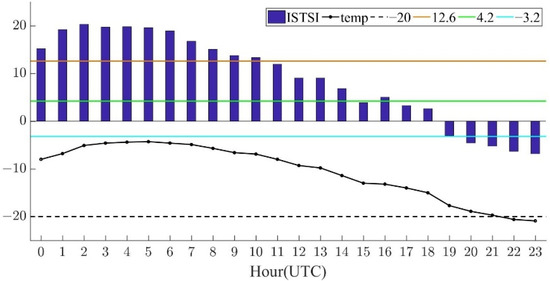
Figure 7.
The 24 h change in temperature and ice–snow tourism suitability index (ISTSI) at Donggang station on 8 January 2022 (the unit of temperature is °C).
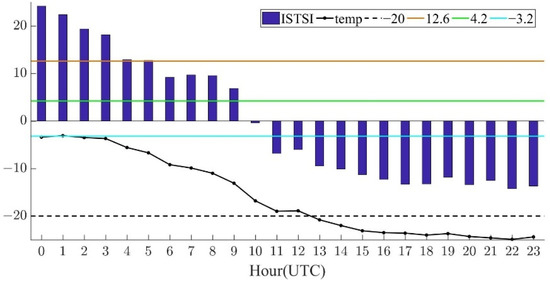
Figure 8.
The 24 h change in temperature and ISTSI at Yongji station on 8 January 2022 (the unit of temperature is °C).
5. Conclusions
In the context of climate warming, this study provides a statistical analysis of the changes in monthly temperature and corresponding CCI values in the Jilin Province of China over the past 40 years. According to the results of the statistical analysis, an evaluation and prediction model is constructed for the ISTSI to predict the suitability of ice–snow tourism. The results are as follows. (1) The climate of Jilin Province has become hotter in summer and colder in winter in the past 10 years. The ranges of temperature rises and falls in various areas of Jilin Province are unevenly distributed. The temperature rises and falls in the eastern and southeastern mountainous areas are weaker than those in other areas, whereas the central and western areas show a trend of bipolar strengthening, with a large range of warming and evident cooling. (2) The CCI of Jilin Province has improved from March to November in the last 10 years, and people’s tourism experience is more comfortable than in the past 30 years. (3) The evaluation and prediction model for the ISTSI is constructed by comprehensively considering the CCI, ICL, and precipitation. It not only considers the impacts of natural conditions, but also integrates people’s subjective initiatives and simplifies the evaluation process.
6. Discussion
The evaluation and prediction model for the ISTSI is constructed by comprehensively considering the impact of climate conditions and human factors on ice–snow tourism. The ISTSI can objectively evaluate the suitability of ice and snow environments for travel and provides scientific guidance for tourists to travel. The study has theoretical value and practical significance. For different terrain and altitude, there are complex and changeable climate types on different scenic spots. It is still difficult to evaluate the tourism suitability of different scenic spots and provide a refined tourism guarantee for tourists with a single ISTSI. These factors have not been taken into account in this analysis, and a further in-depth study is needed.
Author Contributions
Conceptualization, methodology, writing, and editing: J.Y.; analysis of the data: W.C.; analysis of the data and revision of the manuscript: J.Y. and M.Z. All authors have read and agreed to the published version of the manuscript.
Funding
This research was funded by the Program of Science and Technology Development Plan of Jilin Province of China under Grant 20220601060FG.
Institutional Review Board Statement
Not applicable.
Informed Consent Statement
Not applicable.
Data Availability Statement
Not applicable.
Acknowledgments
Thanks to the anonymous reviewers for their helpful suggestions and comments.
Conflicts of Interest
The authors declare no conflict of interest.
References
- Cetin, M. Climate comfort depending on different altitudes and land use in the urban areas in Kahramanmaras City. Air Qual. Atmos. Health 2020, 13, 991–999. [Google Scholar] [CrossRef]
- Scott, D.; Hall, C.M.; Gossling, S. Global tourism vulnerability to climate change. Ann. Tour. Res. 2019, 77, 49–61. [Google Scholar] [CrossRef]
- De Freitas, C.R.; Scott, D.; McBoyle, G. A second generation climate index for tourism (CIT): Specification and verification. Int. J. Biometeorol. 2008, 52, 399–407. [Google Scholar] [CrossRef]
- Blazejczyk, K.; Epstein, Y.; Jendritzky, G.; Staiger, H.; Tinz, B. Comparison of UTCI to selected thermal indices. Int. J. Biometeorol. 2012, 56, 515–535. [Google Scholar] [CrossRef] [PubMed]
- Gungor, S.; Cetin, M.; Adiguzel, F. Calculation of comfortable thermal conditions for Mersin urban city planning in Turkey. Air Qual. Atmos. Health 2021, 14, 515–522. [Google Scholar] [CrossRef]
- Zeng, D.; Wu, J.; Mu, Y.; Deng, M.; Wei, Y.; Sun, W. Spatial-temporal pattern changes of UTCI in the China-Pakistan economic corridor in recent 40 years. Atmosphere 2020, 11, 858. [Google Scholar] [CrossRef]
- Mölders, N. Outdoor universal thermal comfort index climatology for Alaska. Atmos. Clim. Sci. 2019, 9, 558–582. [Google Scholar] [CrossRef][Green Version]
- Vinogradova, V. Using the universal thermal climate index (UTCI) for the assessment of bioclimatic conditions in Russia. Int. J. Biometeorol. 2021, 65, 1473–1483. [Google Scholar] [CrossRef]
- Junyuan, Z.; Shengjie, W. Spatio-temporal evolution and prediction of tourism comprehensive climate comfort in Henan province, China. Atmosphere 2021, 12, 823. [Google Scholar]
- Michelle, R.; Daniel, S.; Lindsay, M.; Ravidya, B.; Adrian, T.; Roché, M.; Amanda, C. An Inter-comparison of the holiday climate index (HCI: Beach) and the tourism climate index (TCI) to explain Canadian tourism arrivals to the Caribbean. Atmosphere 2020, 11, 412. [Google Scholar]
- Hasanah, N.; Maryetnowati, D.; Edelweis, F.; Indriyani, F.; Nugrahayu, Q. The climate comfort assessment for tourism purposes in Borobudur Temple Indonesia. Heliyon 2020, 6, e05828. [Google Scholar] [CrossRef] [PubMed]
- Houghten, F.C.; Yaglou, C.P. Determining lines of equal comfort. Trans. Am. Soc. Heat. Vent. Eng. 1923, 29, 165–176. [Google Scholar]
- Terjung, W.H. Physiologic climates of the conterminous United States: A bioclimatic classification based on man. Ann. Assoc. Am. Geogr. 1966, 56, 141–179. [Google Scholar] [CrossRef]
- Siple, P.A.; Passel, C.F. Measurements of dry atmospheric cooling in sub-freezing temperatures. Proc. Am. Philos. Soc. 1945, 89, 177–199. [Google Scholar]
- Defreitas, C.R. Human climates of northern China. Atmos. Environ. 1979, 13, 71–77. [Google Scholar] [CrossRef]
- Yu, Z.K.; Sun, G.N.; Luo, Z.W.; Feng, Q. An analysis of climate comfort degree and tourism potential power of cities in Northern China in summer to the north of 40° N. Nat. Resour. J. 2015, 30, 327–339. [Google Scholar]
- Zare, S.; Hasheminejad, N.; Shirvan, H.E.; Hemmatjo, R.; Sarebanzadeh, K.; Ahmadi, S. Comparing universal thermal climate Index (UTCI) with selected thermal indices/environmental parameters during 12 months of the year. Weather Clim. Extreme 2018, 19, 49–57. [Google Scholar] [CrossRef]
- Jing, H. Analysis and application of comfort index. Meteorol. Mon. 2001, 27, 47–51. [Google Scholar]
- Jigang, B.; Yifang, C. Tourism Geography, 3rd ed.; Higher Education Press: Beijing, China, 2012; pp. 125–129. [Google Scholar]
- Yao, X.; Zhang, M.; Zhang, Y.; Xiao, H.; Wang, J. Research on evaluation of climate comfort in northwest China under climate change. Sustainability 2021, 13, 10111. [Google Scholar] [CrossRef]
- Cao, Y.Q.; Gao, L. Regional characteristics of climate comfort in summer in Liaoning during past 30 years. Sci. Geogr. Sin. 2016, 36, 1205–1211. [Google Scholar]
- Noome, K.; Fitchett, J.M. An assessment of the climatic suitability of Afriski Mountain Resort for outdoor tourism using the Tourism Climate Index (TCI). J. Mt. Sci. 2019, 16, 2453–2469. [Google Scholar] [CrossRef]
- Hongqiao, W.; Xiangjun, M.; Zhengfang, W. Temporal and spatial responses of climate comfortable index in Jilin Province. J. Arid. Land Resour. Environ. 2012, 26, 141–148. [Google Scholar]
- Yong, X.; Feng, G.; Doudou, L. Construction of the tourism meteorological index system in Jilin Province. In Proceedings of the 33rd Annual Meeting of China Meteorological Society, Xi’an, China; 2016. [Google Scholar]
- Tian, L.; Xiaoxia, Z.; Yuanyuan, D.; Shaojun, Q. Jilin Province winter tourism meteorological index method study. In Proceedings of the 35th Annual Meeting of China Meteorological Society, Hefei, China, 24–26 October 2018. [Google Scholar]
- Wu, F.; Yang, X.; Shen, Z.; Yi, Z. Long-term trends and spatiotemporal variations of climate comfort in China during 1966–2016. Therm. Sci. 2020, 24, 2445–2453. [Google Scholar] [CrossRef]
- Andi, Y. To Jilin to experience the “drunk beauty” ice and snow. Sino-Foreign Cult. Exch. 2022, 1, 58–60. [Google Scholar]
Publisher’s Note: MDPI stays neutral with regard to jurisdictional claims in published maps and institutional affiliations. |
© 2022 by the authors. Licensee MDPI, Basel, Switzerland. This article is an open access article distributed under the terms and conditions of the Creative Commons Attribution (CC BY) license (https://creativecommons.org/licenses/by/4.0/).